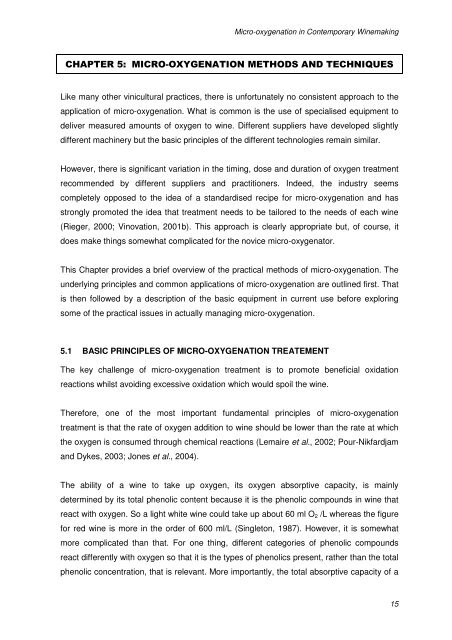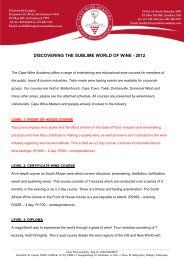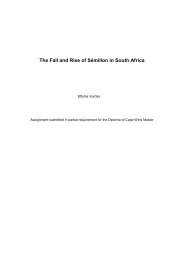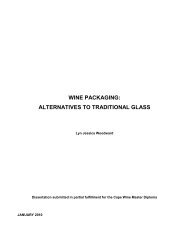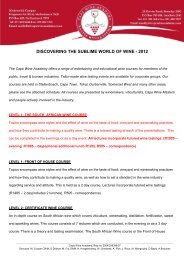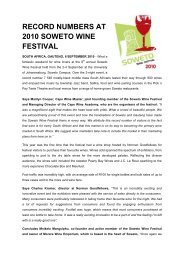micro-oxygenation in contemporary winemaking - Cape Wine ...
micro-oxygenation in contemporary winemaking - Cape Wine ...
micro-oxygenation in contemporary winemaking - Cape Wine ...
Create successful ePaper yourself
Turn your PDF publications into a flip-book with our unique Google optimized e-Paper software.
Micro-<strong>oxygenation</strong> <strong>in</strong> Contemporary W<strong>in</strong>emak<strong>in</strong>gCHAPTER 5: MICRO-OXYGENATION METHODS AND TECHNIQUESLike many other v<strong>in</strong>icultural practices, there is unfortunately no consistent approach to theapplication of <strong>micro</strong>-<strong>oxygenation</strong>. What is common is the use of specialised equipment todeliver measured amounts of oxygen to w<strong>in</strong>e. Different suppliers have developed slightlydifferent mach<strong>in</strong>ery but the basic pr<strong>in</strong>ciples of the different technologies rema<strong>in</strong> similar.However, there is significant variation <strong>in</strong> the tim<strong>in</strong>g, dose and duration of oxygen treatmentrecommended by different suppliers and practitioners. Indeed, the <strong>in</strong>dustry seemscompletely opposed to the idea of a standardised recipe for <strong>micro</strong>-<strong>oxygenation</strong> and hasstrongly promoted the idea that treatment needs to be tailored to the needs of each w<strong>in</strong>e(Rieger, 2000; V<strong>in</strong>ovation, 2001b). This approach is clearly appropriate but, of course, itdoes make th<strong>in</strong>gs somewhat complicated for the novice <strong>micro</strong>-oxygenator.This Chapter provides a brief overview of the practical methods of <strong>micro</strong>-<strong>oxygenation</strong>. Theunderly<strong>in</strong>g pr<strong>in</strong>ciples and common applications of <strong>micro</strong>-<strong>oxygenation</strong> are outl<strong>in</strong>ed first. Thatis then followed by a description of the basic equipment <strong>in</strong> current use before explor<strong>in</strong>gsome of the practical issues <strong>in</strong> actually manag<strong>in</strong>g <strong>micro</strong>-<strong>oxygenation</strong>.5.1 BASIC PRINCIPLES OF MICRO-OXYGENATION TREATEMENTThe key challenge of <strong>micro</strong>-<strong>oxygenation</strong> treatment is to promote beneficial oxidationreactions whilst avoid<strong>in</strong>g excessive oxidation which would spoil the w<strong>in</strong>e.Therefore, one of the most important fundamental pr<strong>in</strong>ciples of <strong>micro</strong>-<strong>oxygenation</strong>treatment is that the rate of oxygen addition to w<strong>in</strong>e should be lower than the rate at whichthe oxygen is consumed through chemical reactions (Lemaire et al., 2002; Pour-Nikfardjamand Dykes, 2003; Jones et al., 2004).The ability of a w<strong>in</strong>e to take up oxygen, its oxygen absorptive capacity, is ma<strong>in</strong>lydeterm<strong>in</strong>ed by its total phenolic content because it is the phenolic compounds <strong>in</strong> w<strong>in</strong>e thatreact with oxygen. So a light white w<strong>in</strong>e could take up about 60 ml O 2 /L whereas the figurefor red w<strong>in</strong>e is more <strong>in</strong> the order of 600 ml/L (S<strong>in</strong>gleton, 1987). However, it is somewhatmore complicated than that. For one th<strong>in</strong>g, different categories of phenolic compoundsreact differently with oxygen so that it is the types of phenolics present, rather than the totalphenolic concentration, that is relevant. More importantly, the total absorptive capacity of a15


